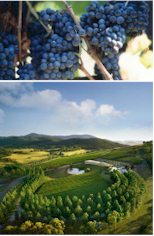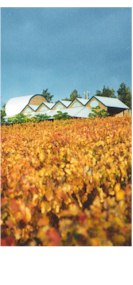


TarraWarra Estate is a 400 hectare property on a prime site at the warm eastern end of the Yarra Valley in southern Victoria. The vineyard is planted on a north facing slope at approximately 100 metres elevation, and comprises 12 hectares of Chardonnay and 17 hectares of Pinot Noir, most of which was planted in 1983.

With twenty years of history and heritage, TarraWarra Estate Pinot Noir and Chardonnay represent the vision of Marc and Eva Besen to produce premium wine crafted to bring out the particular aspects of each vintage while consistently concentrating on balancing structure and elegance.
Since the first vintage more than 20 years ago, Tarrawarra have established themselves as one of Australia's great wine estates. TarraWarra Chardonnay and Pinot Noir have consistently received widespread acclaim and many prestigious Australian and international awards. TarraWarra Estate is a must-see destination where visitors are invited to reward their senses with the inspired combination of fine wines, delicious food and wonderful Australian art in a magnificent setting. These wines are of great character and depth, reflecting the outstanding quality of the 100% estate grown fruit from the unique microclimate of the site chosen specifically for these varieties.
TarraWarra have carved out a reputation as one of the Yarra's leading lights with an intensity and concentration rarely seen in that region. "In the hands of winemaker Clare Halloran, the style of TarraWarra wines has become more elegant and refined" -Peter Bourne, Gourmet Traveller

There are 23 different blocks at TarraWarra Estate, with most of these being less than one hectare, the majority of the Chardonnay was planted in 1983 and while the majority of the Pinot Noir was planted in 1984, additional plantings were made up until 1995. The majority of the vineyard is planted at a density of 2,200 vines per hectare with a very small area planted more densely at 3,000 vines per hectare. In recent years, older blocks of Chardonnay have been grafted over to Mendoza clone to add another dimension to the structure of the TarraWarra Estate Chardonnay.
The soil comprises a fairly thin layer of grey loam over clay. This soil composition leads to reduced vigour in the vines and the clay aids consistency by retaining water. As the majority of the vines are at least 20 years old, the fruit is consistently more concentrated and of a good acid balance with less fruit produced than from more vigorous younger vines. This significant vine age contributes noticeably to wines giving them more structure and greater balance.
While some blocks were planted trialling different trellising systems, the Estate is moving to all VSP trellis. This system has proved advantageous in not only growing the cordon relatively low to the earth to make the most of available radiant heat, but also in providing a significantly greater leaf canopy, important to shade fruit from sunburn and to improve ripening with increased leaf area/energy.
